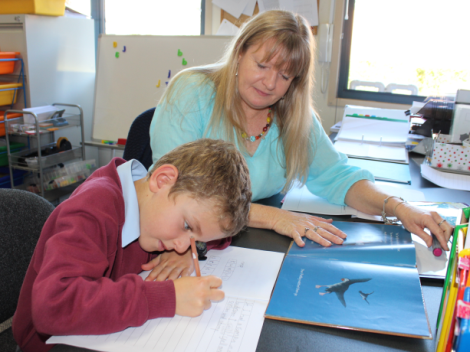 |
| Christine Stafford with Year 2 student Aaron during an L2 session at St John's Primary, Riverstone |
Students are receiving more one-to-one instruction in literacy and comprehension thanks to a new Literacy Lessons (L2) program being trialled in 8 primary schools across the diocese.
L2 is an intervention program targeting Year 2 students most at risk in comprehension and writing and is aimed at improving students’ skills to enable them to achieve Stage 1 literacy outcomes.
Implemented at the beginning of Term 3, trained Reading Recovery teachers* work with selected Year 2 students (two per school) engaging in 30 minute one-to-one intervention every day.
At St John’s Primary, Riverstone, Reading Recovery teacher Christine Stafford said her students are showing significant improvements in their reading and writing.
‘We are focusing on comprehension and using picture books to generate ideas for writing because that is really rich language,’ said Christine. ‘I have noticed that the students are a lot more confident in their learning in the time that I’ve been working with them. They are more phrased and fluent when they are reading to me, their writing is more focused and they are starting to use richer language and improve their structure.
‘One student in particular has really jumped,’ she said. ‘Before L2, he was reading at the lowest level in guided reading in the classroom, now he is really motivated and trying to read quality literature with me during our sessions.’
Trish Reilly, teaching educator and Reading Recovery tutor at Catholic Education Diocese of Parramatta, said targeting students at risk of falling behind in literacy in Year 2 is important as they transition from ‘learning to read’ to ‘reading to learn.’
‘Our aim is to reduce the number of students requiring long-term intervention in Year 3 and beyond,’ said Trish. ‘This is a second wave intervention that focuses on comprehension and writing through the use of quality literature and the quality talk framework.’
She said students need to be able to take control of their learning and that teachers select rich, interesting, picture books to provide opportunities for a variety of interpretations on a topic. They then strategically ask the students questions to encourage them to access meaning from the text.
‘It is through the discussion that the teacher guides the child’s thinking and understanding. A written response leads to further clarification of the ‘big ideas’ of the text,’ said Trish.
Christine said parents are very positive about the program and keen to support their child’s learning at home.
‘Our parents are happy and excited to see their children getting help and they can see their children are a lot more confident at home,’ she said. ‘One parent came and asked for guidance about what she can do to reinforce the learning and now her two younger children join in reading together at home, which is not only great for my student but for his siblings as well as they reach school age.’
In addition to working with students daily, L2 teachers also participate in fortnightly professional learning sessions to refine their skills and complete a series of observation tasks to analyse the shifts in their teaching decisions as they work with their students.
* Reading Recovery is an early intervention strategy aimed at Year 1 students who require additional support in reading and writing after their first year of school. Reading Recovery teachers undergo training run through Catholic Education, participating over two years in assessment training, fortnightly in-service sessions and regular professional learning sessions to refine their skills. There are currently 81 Reading Recovery teachers working with the most vulnerable Year 1 students in the Diocese.
